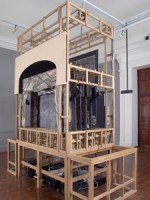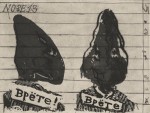Column Name
Title
The art of William Kentridge as seen in the Museum of Modern Art’s “William Kentridge: Five Themes” is staggering in its variety, but at the same time remarkably cohesive. From his first theme, “Ubu Roi,” to the last, “The Nose,” the artist’s use of repeated imagery and symbolism, fragmentation, and constant flux informs every piece in the show.
Body
Although the exhibit comprises more than 120 works in 10 mediums and numerous formats, the curators and installers, together with the artist, have set up a kind of exhilarating rhythm as viewers proceed from room to room. Thus the museum has successfully organized a progression of huge and small drawings and prints, video, film, model theaters, and musical soundtracks in vast, high-ceilinged corridors and galleries. Installing the MoMA show—while simultaneously directing and supervising the Metropolitan Opera’s production of Shostakovich’s The Nose—Kentridge, along with his co-workers, has achieved a monumental feat.
Kentridge’s interdisciplinary work seamlessly bridges visual art, film, opera, and theater. Indeed, the relationship among the various art forms is intrinsic to his working methods. For example, to make his films, he draws each and every frame and arduously shoots his drawings until the animation is complete. He doesn’t have a storyboard, but, rather, lets each story unfold from a logic inhabited by the drawings themselves. The artist often stresses the low-tech aspect of his films and opera design.
Kentridge’s early production focused on his life experiences in his native South Africa. His brilliant combination of aesthetics, political activism, personal life, and spectacle can serve as a model for anyone who seeks to explore this sort of multivalent art. In the beginning he depicted violence, hatred, and greed, as exemplified by South Africa’s abhorrent apartheid system; but his subject matter has expanded over the years to include cultural history and memory (or lack thereof) in different parts of the world. Most recently, his interpretation of the The Nose extends his vision to deal with Stalinist Russia and its repression of modernist art.
As noted, there is a strong kinship among each of the themes explored in the exhibit.
For example, Ubu Roi, also known as King Turd, is an over-inflated, greedy egotist. Soho Eckstein, Kentridge’s alter ego in the second theme, is a fat, rich industrialist and colonialist, racked with guilt. Eckstein quite literally cries himself a river. “The Nose” confronts a hierarchy in which a man’s nose, severed from his face, takes on its own persona and reaches a higher rank than its previous possessor, refusing even to speak to him.
All explore the oxymoron of absurd logic. The artist has said that “brutal comedy” is one way of dealing with world cataclysms. Indeed, Kentridge is a fitting successor to Gogol, who wrote the original satirical short story The Nose, and Shostakovich, who composed the ironic music. The ridiculous scenario mirrors Kentridge’s lifelong concerns: inequalities and fragmentation of society, as well as individuals.
In the trailer for the Met’s production of The Nose, which you can see on the company’s Web site (metopera.org), a few typographical letters and constructivist/futurist elements—red, white, gray, and black crosses, triangles, and spheres—dance across the screen, intermingling with a silhouetted procession of figures, and collapsing into a heap of black ink. From the ink splotch a horse stretches out an inky leg, arises, and delicately saunters off. All this is accompanied by Shostakovich’s deceptively cheerful soundtrack, reminiscent of typing noises. Cut to a typewriter keyboard, then a large nose superimposed successively onto a piano player, a dancer, a diver (where it takes its nose dive), and astride a horse. But the horse collapses and the nose disappears; then the horse reappears happily without its rider. The artist drew, tore, pasted, and then filmed the component parts. In some segments, drawings alternate with actual archival film clips showing marching bands. “Cry Me a River” and “Nose Dive” might be sources for visual puns. In lesser hands, this could have been trite, but in Kentridge’s masterly ones, they are instead inventive and witty.
The MoMA exhibition, as its title indicates, is divided into five major themes, and arranged chronologically. It starts with “Ubu Roi,” originally a play by Alfred Jarry that premiered in Paris in 1896 and concerned greed and vulgarity; it scandalized the audience, causing general rioting. Its intent—“épater le bourgeois,” or, to shock the middle classes—influenced later absurdist theater, Dada, and Surrealism. In the “Ubu Roi” section of the exhibit, drawings and etchings hung along the walls lead to a gallery in which you can see the first film, Shadow Procession. This march of silhouetted people carrying burdens recurs many times in Kentridge’s films as well as in a scroll-like multipanel, accordion-folded book, Portage. It represents emigrants and refugees, alternately hopeful and despairing. They embody the constant flux and movement of society at large, which reflects both Kentridge’s oeuvre and the larger progression of the exhibit as a whole. Observing some resemblances to Kara Walker’s silhouette art, I discovered that the two of them actually collaborated on a video in 2004, which was shown last year at the Irish Museum of Modern Art in Dublin.
Kentridge spoke about his life and work at the press preview. When he first arrived in New York City in 1986, he said, with a portfolio of drawings under his arm, galleries paid no attention to him. He was “astonished” at his success (although he has been a major art world figure for at least the last 20 years). He spoke articulately, like the theater person he is. (He came to drawing and print-making from acting and directing.) But he had to run off to attend a rehearsal of The Nose, which ran March 5-25 at the Met.
Kentridge is a worthy successor to Goya—someone who grapples with the evils of his world and makes art out of them, causing us to laugh and cry all at once.
You will want to visit the exhibit more than once, as it takes time to see all the films—and it is well worth the trouble.
“William Kentridge: Five Themes” runs through May 17 at the Museum of Modern Art, 11 West 53rd Street between Fifth and Sixth Avenues. The museum is open Sunday, Monday, Wednesday, Thursday, and Saturday from 10:30 a.m. to 5:30 p.m.; and Friday from 10:30 a.m. to 8 p.m.; it is closed on Tuesday. (212) 708-9400; www.moma.org.






